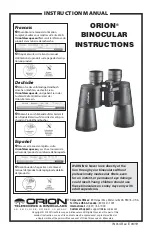
Diopter Adjustment and Focusing
1. Adjust eyecups interpupillary distance as described in the previous sections.
2. Set the diopter adjustment ring to zero and view a distant object.
3. Keep both eyes open at all times.
4. Using a lens cover or your hand, cover the objective (front) lens of the same side of the
binocular that has the diopter adjustment ring. This is usually the right side.
5. Using the center focus wheel, focus on a distant object with fine detail (e.g., brick wall,
tree branches, etc.) until it appears as sharp as possible.
6. Uncover the objective lens on the diopter side, cover the other objective lens, the left
side, then view the same object.
7. Using the diopter adjustment ring, move the dipoter adjustment marker to the “+” or “-”
till you reach focus.
Caution should be used as over turning or forcing the diopter ring can cause damage or
cause the eyepiece to break away from the chassis.
8. Your binocular should now be adjusted for your eyesight. Focusing for any distance can
now be done simply by turning the center focus wheel. Make a note of your diopter
setting for future reference.
Neckstrap Attachment
To securely attach your binocular to the binocular strap:
1. Thread the end of the strap from the bottom up through the strap attachment loop.
2. Hold the buckle and thread the end of the strap inside the buckle.
3. Adjust the overall length and pull the strap webbing tight so it is secure within the buckle.
Diopter
Adjustment
Ring
Diopter
Adjustment Marker
Waterproof / Fogproof Models
(this will be noted on the product packaging)
National Geographic binoculars are designed and built utilizing the latest waterproof and
fogproof technology. Waterproof models are O-ring sealed for complete moisture protection.
Fogproof protection is achieved from dry nitrogen purging that removes all internal moisture.
Water-Resistant Models
(this will be noted on the product packaging)
Binoculars that are water-resistant have a housing that protects the binocular from minor
exposure to damp conditions such as mist or splashes and are not protected from full
submergence in water.
Tripod Mounting
(tripod and tripod adapter not included)
To attach the binocular to a tripod or mono-pod, unscrew (counter-clockwise) the cap which
covers the threaded socket at the far end of the center hinge, and set it aside in a safe
place. Use a compatible binocular tripod adapter accessory to attach your binocular to any
standard tripod in a horizontal position to provide a stable image during prolonged viewing.
Care and Cleaning
Your binocular will provide years of trouble-free service if it receives the normal care you
would give any fine optical instrument.
• Do not expose non-waterproof models to heavy rain or other excessive moisture.
• If your binocular has roll-down, flexible eyecups, store it with the eyecups up. This avoids
excessive stress and wear on the eyecups in the down position.
• Avoid sharp impacts. Use the included neckstrap to avoid accidentally dropping the
binoculars to prevent mis-alignment of the optics.
• When not using them, store your binoculars in the provided case in a cool, dry place.
• Avoid storing the binoculars in hot places, such as the passenger compartment of a vehicle
on a hot day. The high temperature could adversely affect the lubricants and sealants. Never
leave the binocular where direct sunlight can enter either the objective or the eyepiece lens.
Damage may result from the concentration (burning glass effect) of the
sun’s rays.
• All moving parts of the binocular are permanently lubricated. Do not try to lubricate them.
To Clean Your Binoculars Lenses
1. Blow away any dust or debris on the lens (or use a soft lens brush).
2. To remove fingerprints or other smears, clean with a soft cotton cloth rubbing in a circular
motion. A “microfiber”cleaning cloth (available from camera or computer retailers) is ideal for
the routine cleaning of your optics.
3. For a more thorough cleaning, photographic lens tissue and photographic-type lens
cleaning fluid or isopropyl alcohol may be used. Always apply the fluid to the cleaning cloth –
never directly on the lens.
©2021 National Geographic Partners LLC. All rights reserved.
NATIONAL GEOGRAPHIC and Yellow Border Design are trademarks of the
National Geographic Society, used under license.
©2021 Explore Scientific, LLC
1010 S. 48th Street, Springdale AR 72762.
All rights reserved. Made in China.
explorescientific.com | 866.252.3811
Contents, colors and specifications may vary.
V042021




















